They fought gallantly and when it was over on Saturday afternoon, the horse, I'll Have Another, and the chessplayer, Hikaru Nakamura, 24, were declared winners almost at the same time. The comparison between the Preakness Stakes horse race held in Baltimore, Maryland, and the 2012 U.S. Chess Championship in Saint Louis, Missouri, may seem out of place, but both races had a lot of things in common.
Two best U.S. grandmasters, the defending champion Gata Kamsky and the top-rated American Nakamura, went neck-to-neck in the 11-round robin, leaving others far behind them. Two best horses at the Kentucky Derby and Preakness Stakes, Bodemeister and I'll Have Another, trounced the competition by eight horse lengths. An exciting come-from-behind victory was featured on the chessboard as well as on the race track.
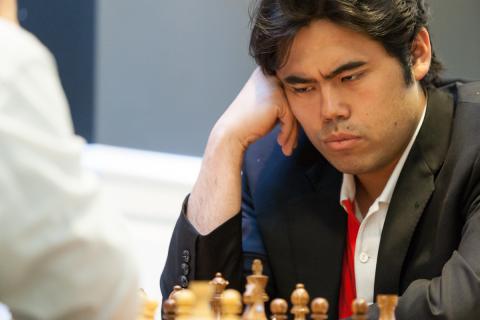
Nakamura wanted the title badly. He was rated number seven in the world and it was a matter of prestige for him, although the first prize of $40,000 wasn't bad either. He was even talking about breaking Bobby Fischer's record. A special prize of $64,000 to match Fischer's perfect 11-0 record from the 1964 U.S. Championship was out of his reach - nobody is winning all games these days. But Nakamura thought he could break Fischer's highest rating record of 2785, although what Bobby did 40 years ago is not comparable to today's ratings. Fischer still leads the all time rating list of 50 best players.
Using unusual opening schemes, attacking left and right, grinding points in very long games and trying everything possible to score, Hikaru was still a half point behind Kamsky with two rounds to go. They met in the penultimate round and the odds were against Hikaru. He had the black pieces against one of the world's best defenders with world championship experience. But Kamsky cracked under pressure, played passively and Nakamura scored the most needed victory.
In the last round, Nakamura defeated the veteran Yasser Seirawan, 52, and with that remarkable finish, Hikaru clinched his third U.S. title with 8.5 points in 11 games, a full point ahead of his main rival Kamsky. Alexander Onischuk finished third with a solid performance, scoring 6.5 points.
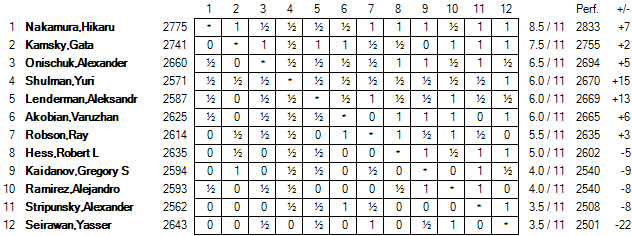
Irina Krush won the U.S.Women Championship in the playoff, beating the defending champion Anna Zatonskih 2-0 after both players finished the tournament with a 7-2 score.
A championship journey
Nakamura began the championship sharply, outplaying Robert Hess in the Evans gambit, the only correct gambit among real gambits according to the legendary David Bronstein.
Nakamura,Hikaru (2775) - Hess,Robert (2635)
Nakamura's pieces are in a huddle, contemplating the final blow. Hikaru finds a quick way to get the black king.
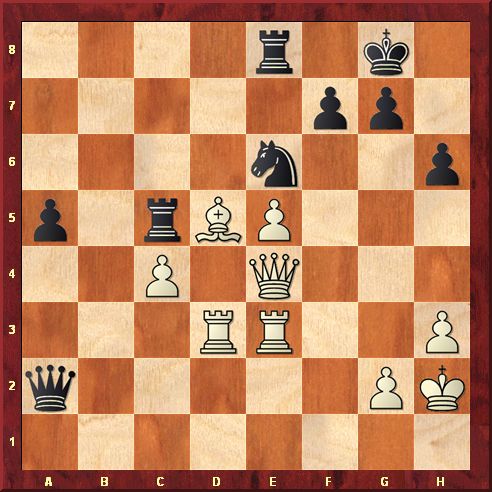
29.Bxe6! fxe6 (29...Rxe6 30.Rd8+ Re8 31.Rxe8 mate.)
30.Rd7 (Sealing the victory, threatening 31.Qg6 or 31.Rg3.) 30...Kh8 (After 30...Qf2 31.Qg6 Qf8 32.Rf3 wins.)
31.Rxg7! (The rook sacrifice brings the black king out and white mates soon.) 31...Kxg7 32.Rg3+ Kf8 33.Qh7 (There is no good defense against 34.Qg7 mate or 34.Rg8 mate.) Black resigned.
Against the talented youngster Ray Robson, 17, Nakamura composed a beautiful king's journey, balancing on the edge.
Nakamura,Hikaru (2775) - Robson,Ray (2614)
The black king is almost in a mating net, but Robson threatens to queen with a check shortly.
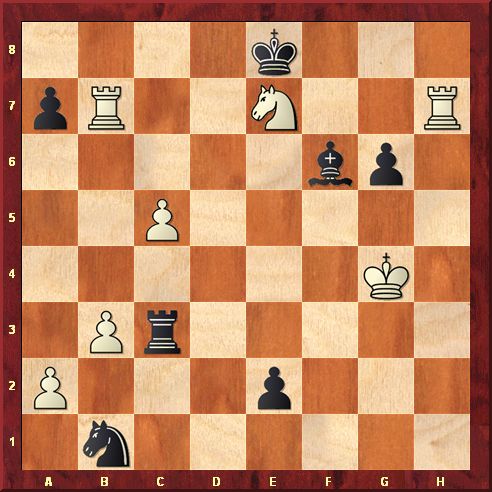
43.Nd5!!
(Nakamura allows black to queen.) 43...Rg3+ 44.Kf4 (After 44.Kxg3 e1Q+ wins for black.) 44...Bg5+ 45.Ke5!!
(A study-like finish. The white king is going to hide on d6.)
45...e1Q+ 46.Kd6
(The white knight is an incredible defender, blocking all possible checks.)
46...Bf4+ (Robson now gives away two pieces, but his desperate effort does not help. After 46...Be7+ 47.Rbxe7+ Qxe7+ 48.Rxe7+ Kf8 49.c6 white wins.) 47.Nxf4 Rd3+ 48.Nxd3 Qg3+ 49.Ne5 (The knight covers all checks and black gets mated with one of the white rooks.) Black resigned.
Nakamura overpowered Gregory Kaidanov with another amazing king's walk, squeezing life out of the black pieces.
Nakamura,Hikaru (2775) - Kaidanov,Gregory (2594)
With the bishop pair, Nakamura's chances are better. But who could have envisoned the positional squeeze working so perfectly. Watch:
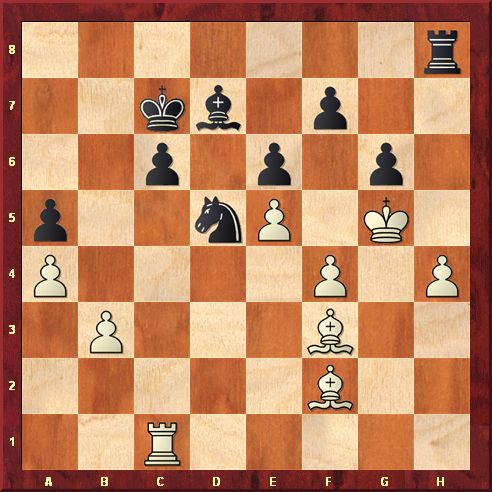
61.f5! Rg8 (Black decides to let the f-pawn march on. He didn't see good prospects after 61...gxf5 62.h5 f6+ [or 62...Be8 63.Bxd5 exd5 64.h6 Bd7 65.Rh1±] 63.exf6 Rg8+ 64.Kh4 Nxf6 65.Bg3+ Kb6 66.Bf4 and the h-pawn advances slowly but surely.)
62.f6! (Creating a potential passed pawn, Hikaru only needs to clear the way for his king. There is one thing he shouldn't do: 62.fxg6?? Rxg6+ 63.Kh5 Nf4 mate.)
62...Rh8 63.Rc5 Ra8 64.Kh6
(Nakamura's king moves in decisively.)
64...Nf4 65.Be3 Nh5 66.Bxh5 gxh5 67.Kg7
(Tying up Kaidanov's bishop to the pawn f7, Nakamura is giving black less and less space.)
67...Be8 68.Kf8! Kb7 (After 68...Kd7 69.Rc3, threatening 70.Rd3+ white wins.) 69.Ke7 (Black can hardly move.) 69...Kc7 70.Bd2
(70.Bd2 Kb6 71.Rxa5 and white wins.; 70.Rc1 Rb8 71.Rg1 threatening 72.Rg1-g8, also wins.) Black resigned.
"A knowledge of tactics is the foundation of positional play," claimed Richard Reti, a chess philosopher and one of the leading players of the 1920s. And tactics can crack strong positional walls and take them down. Tactics would fail Seirawan time to time in his successful career.
Seirawan has reached a point in his career when he plays with"ambition without ammunition, " to use Boris Spassky's favorite expression. Yasser suffers in the openings, being out-prepared and out-analyzed by the younger players. But give him an equal position without queens on the board and he will shine.
Kamsky's style has evolved from being a staunch defender to a freelance attacker, capable of creating brilliant tactical gems. He didn't have to think too much against Seirawan. Everything was served up on a platter for him and he just picked the best moves prepared three years ago against Veselin Topalov. The victory briefly catapulted Kamsky into first place.
Kamsky,Gata (2741) - Seirawan,Yasser (2643)
1.e4 c6 2.d4 d5 3.Nc3 dxe4 4.Nxe4 Bf5 5.Ng3 Bg6 6.h4 h6 7.Nf3 Nd7 8.h5 Bh7 9.Bd3 Bxd3 10.Qxd3 e6 11.Bd2 Ngf6 12.0-0-0 Be7 13.Ne4 Nxe4 14.Qxe4 Nf6 15.Qd3 0-0 16.Kb1 c5 17.g4!?
(White is going for a "blitzkrieg," storming the black king with bold sacrifices.)
17...Nxg4 18.Qe2!
(Killing two birds with one stone: the queen protects the pawn on f2 and at the same time prevents black from playing f7-f5. One can also play more daringly with either 18.Rdg1!? or 18.Rhg1!?)
18...Kh8
(A new move. The king goes out of the line of fire: the g-file. But other moves such as 18...Qd5, 18...Qb6 or 18...cxd4 were played with success.) 19.Rhg1 Nf6 20.dxc5 Qc7 21.Ne5 Bxc5?
(Seirawan overlooks a pretty combination. Tactics was always his weaker side. 21...Rad8 was the proper answer.)
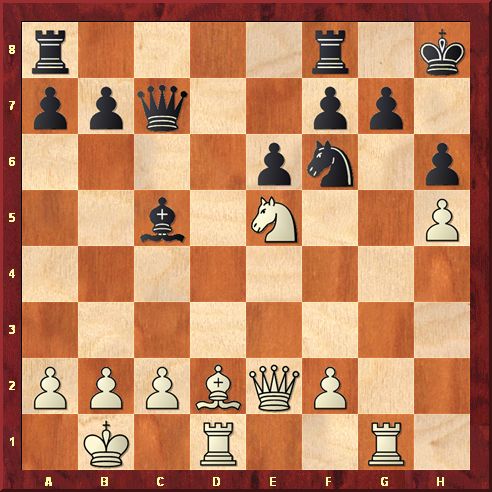
22.Bxh6! gxh6 23.Rd7!!
(The point of the sacrifices: white deflects the knight from the defense of the black king. Kamsky admitted he had prepared all this for the World Chess Challenge match against Veselin Topalov in 2009 in Sofia.)
23...Qxd7 (After 23...Nxd7 24.Qd2 Kh7 25.Ng4 and black can't defend the pawn on h6 and gets mated. And after 23...Qb8 24.Rxf7 wins.) 24.Nxd7 Nxd7 (After 24...Rg8 25.Rxg8+ Rxg8 26.b4 white should win.) 25.Qd2 (The game is basically over and Kamsky plays the rest well.) 25...Kh7 26.b4 (26.Qxd7 Bxf2 27.Qd3+ Kh8 28.Qc3+ e5 29.Rf1 also wins.) 26...Rad8 27.bxc5 Nf6 (After 27...Nxc5 28.Qf4 Rd5 29.Qf6 wins.) 28.Qf4 Ne8 29.Qe4+ Kh8 30.Qxb7 Ng7 31.Qxa7 Rc8 32.Rd1 Nf5 33.Rd7 Kg7 34.a4 Kf6 35.a5 Black resigned.
Nakamura began the most important game of the tournament with a half-point handicap. But he equalized rather quickly with the black pieces in the Sicilian Najdorf and had Kamsky under pressure throughout the game. Hikaru had a slim but important lead going into the last round.
Kamsky,Gata (2741) - Nakamura,Hikaru (2775)
1.e4 c5 2.Nf3 d6 3.d4 cxd4 4.Nxd4 Nf6 5.Nc3 a6 6.a4 e5 7.Nf3 Be7 8.Bc4 0-0 9.0-0 Be6 10.Bb3 Nc6 11.Bg5 Na5!?
(Nakamura begins the battle for the square c4. The knight move made Kamsky unhappy and he took almost a half-hour before he played his next move.)
12.Bxf6 Bxf6 13.Bd5
(Landing both the bishop and the knight on the outpost d5 at the same time would have been ideal for white. It would free the queenside pawns and they could step into action. But chess does not work this way. Black is able to create a typical Sicilian counterplay along the c-file, but the chances are roughly equal. For example 13.Nd5 Nxb3 14.cxb3 Rc8 15.Nxf6+ gxf6=; 13.Ba2 Rc8 14.Nd5 Nc4=)
13...Rc8 14.Nd2 (Kamsky covers everything he can, but not for long.) 14...Qc7 15.Re1 Bg5! 16.Nf1 Qb6!
(It is interesting how quickly white's game detoriates. Kamsky played rather passively and it is not easy for him to find a good play. Nakamura, on the other hand, has a green light on the queenside.)
17.Rb1 Nc4 18.Qe2 Bh6 [18...g6] 19.h4 Qb4 20.g3 Rc7 [20...Nxb2 21.Nd1] 21.Kg2 Nb6 (Nakamura outplayed his opponent and is ready to cash in. After 21 moves only, Kamsky is in trouble with the white pieces and has to give up a pawn.) 22.Bb3 Bxb3 23.cxb3 Qxb3 24.a5 Na4 25.Nh2 [25.Nd5 Rc2]
25...g6 (Nakamura decides to escape with his bishop and who could blame him. After 25...Nxc3 26.bxc3 Qxc3 27.Ng4 Qxa5 28.Nxh6+ gxh6 29.Qg4+ Kh8 30.Qf5 Qa2 31.Red1 white is three pawns down, but his rooks are very active.) 26.Ng4 Bg7 27.Nd5 (27.Ne3 f5 28.exf5 gxf5 29.Qd1 Qxd1 30.Rexd1 Nxc3 31.bxc3 white has a good play for a pawn.) 27...Rc2 28.Qe3 Nc5 (After 28...Qxe3 29.Ngxe3 Rxb2 30.Rxb2 Nxb2 31.Rb1 Na4 32.Rxb7 the chances swung in white's favor. Black has two weak pawns: a6 and d6, and white's knights dominate.)
29.h5 (Threatening to win with 30.h6, but black can defend it easily. Kamsky could have tried 29.Ngf6+! Kh8 30.Nd7! Rd8 31.Nxc5 Qxe3 32.Rxe3 Rxc5 33.b4 and the strong knight on d5 fully compensates the small material deficiency.) 29...Qxe3 30.Ngxe3 Rd2 31.Nc4 Rd4 32.Nxd6 Rd8 33.b4 Nd3 34.Nxb7 Nxe1+ 35.Rxe1 Ra8 36.f3?! (White misses his chance to make it more difficult for black. After 36.hxg6 hxg6 37.Ne7+ Kf8 38.Nd5 it is not easy for black to improve his position, for example 38...Ra7 39.Nc5 Kg8 40.Ra1 Bf8 41.Nxa6!! Rxa6 42.b5 and white is a rook down, but his extra passed pawns should not be underestimated.) 36...Bf8 37.Rc1 [37.Nc5 gxh5] 37...Bxb4 38.Rc7 (38.h6 Bf8 39.Rc7 Bxh6 40.Nd6 Bg7) 38...gxh5 39.Kh3 Kg7 40.Kh4? [With the last move before the time control Kamsky allows an unpleasant pin. 40.Nxb4 Rxb4 41.Nd6 was better.) 40...Ra7 41.Kxh5

41...Rxd5! (Simplifying into a winning position with unstoppable a-pawn.) 42.exd5 Bxa5 43.Re7 Bb6 (43...Kf8 44.d6 Bb4 45.Rd7 Bxd6 46.Rxd6 Rxb7 47.Rxa6 Rb3 48.Kg4 h5+ 49.Kxh5 Rxf3 is not that clear.) 44.d6 a5 45.Kg5 (Now the a-pawn is free to run. The only chance was a knight maneuver: 45.Nd8 a4 46.Ne6+ Kf6 47.Nc7 Bxc7 48.dxc7 Ra8 49.Rd7 Rc8 50.Rd6+ Ke7 51.Ra6 Rxc7 52.Rxa4.) 45...a4 46.Kf5 a3 47.Nd8 a2 48.Ne6+ Kh6 49.Ng5 a1Q 50.Nxf7+ Kg7 White resigned.
Nakamura's victory in the last round was the title clincher. He surprised Seirawan already with his second move and continued to gain advantage with unorthodox play. Yasser fell again under heavy tactical blows.
Nakamura,Hikaru (2775) - Seirawan,Yasser (2643)
1.e4 e6 2.f4 (A shocker for Seirawan. He encountered this uncommon move for the first time.) 2...d5 3.e5 c5 4.Nf3 Nc6 5.c3 Nge7 6.Na3 Nf5 7.Nc2 h5 (When he faced Stripunsky with the black pieces two years ago, Nakamura played: 7...d4 8.Bd3 Qb6 and won in 45 moves.) 8.Bd3 (Blocking the d-pawn may look strange, but Nakamura is only delaying the central pawn play.) 8...g6 9.0-0 Be7 10.Bxf5 gxf5 (Capturing towards the center is usually a good idea, but here it isolates the h-pawn.) 11.d4 h4 (11...b6 12.Qe2 a5 13.Qf2 Ba6 14.Rd1 h4) 12.dxc5 Bxc5+ 13.Be3 Be7 (Exchanging the dark bishops would leave black with a bad bishop.) 14.h3 b6 15.Qe2 Nb8 (Seirawan is anxious to occupy the diagonal a6-f1 and is willing to retreat with his pieces. But he also has in mind to re-route his knight to g6. All this costs time. After 15...a5 comes 16.b4!?; Unfortunately, the idea of 15...Bb7 to open up the long diagonal with a pawn sacrifice d5-d4, runs into problems after 16.Rfd1.)
16.Rfd1 Ba6 17.Qe1 Nd7 18.b4 Nf8 19.a4 Bc4 20.Ncd4 Qd7 21.b5 (Creating a nice outpost for the knight.) 21...Ng6 22.Nc6 Kf8 (Trying to finish an artificial castling by placing the king on g7. How could Seirawan have known that he is walking into an ambush? Sacrificing an exchange for the pesky knight 22...Rc8 23.Nd2 Rxc6 24.bxc6 Qxc6 was an option.) 23.Nd2 Bd3 24.c4! (An excellent way to open up the position, using a pin along the d-file.) 24...Kg7 25.cxd5 exd5 (After 25...Qxd5 26.Nxe7 Nxe7 27.Nf3 Rad8 28.Ra3 Qe4 29.Ng5 Qc4 30.Rc3 Qb4 31.Rc7 wins.) 26.Nb1 Bc4(After 26...Bxb1 27.Raxb1 Rhc8 28.Qc3 Qe6 29.Qb3 white wins the d-pawn.)
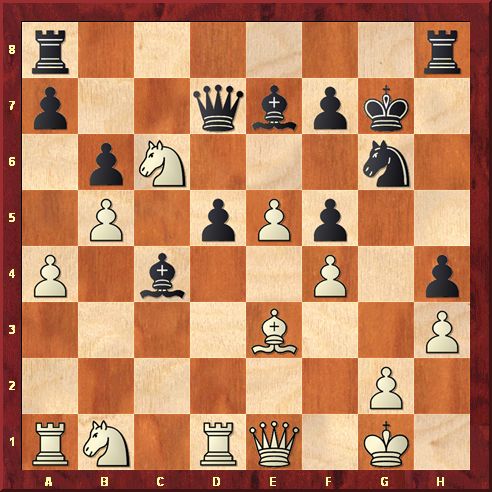
27.Qc3! (Threatening 28.e6+.) 27...Qe6 (The queen is a poor blocker, but white was also threatening 28.Qxc4.) 28.Nd2 (A clever move. After the immediate 28.Nd4 comes 28...Qc8.) 28...Rhc8? (The rook takes the last escape square for the queen, allowing a brutal finish. But after 28...Kh7 29.Nxc4 dxc4 30.Rac1 white should win anyway.) 29.Nd4 Qd7 30.e6! (The diagonal a1-h8 opens up for the final blow: 31.Nd4xf5+ double-check.) Black resigned.
Note that in the replay windows below you can click either on the arrows under the diagram or on the notation to follow the game.
Image by Studio314
